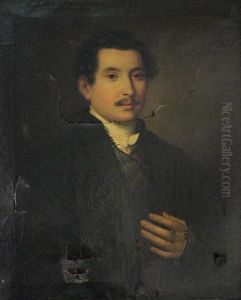Johann Baptist Iii Lampi Paintings
Johann Baptist Lampi the Younger, born in 1781 in Trento, then part of the Bishopric of Trent within the Holy Roman Empire, was an Austrian-Italian painter known for his portraits and historical scenes. He hailed from an illustrious family of artists, being the son of Johann Baptist Lampi the Elder, a prominent portraitist who influenced his style and career. His brother, Franz Xaver Lampi, was also involved in the arts, although to a lesser extent. This familial backdrop provided Johann Baptist III with an environment rich in artistic tradition and expertise from a very young age.
Lampi's early life was marked by his education under the guidance of his father, from whom he learned the fundamentals of painting, focusing particularly on portraiture. The Lampi family moved to Vienna, where Johann Baptist the Elder had been invited to work at the court of the Habsburg monarchy. This move exposed the younger Lampi to a vibrant cultural milieu and further opportunities for artistic development. Johann Baptist III eventually embarked on his own career, establishing himself as a skilled portraitist, much like his father. His works were characterized by their meticulous detail, vibrant portrayal of subjects, and the subtle interplay of light and shadow, which he mastered under his father's tutelage.
Throughout his career, Johann Baptist III Lampi received numerous commissions from the aristocracy and high-ranking officials across the Habsburg Empire, testament to his reputation and the high demand for his portrait work. Despite the shadow cast by his father's significant legacy, Johann Baptist III managed to carve out his own niche in the art world of his time. His portraits are appreciated for their elegance, realism, and the insight they provide into the personalities of his subjects.
Johann Baptist III Lampi's contribution to art history, while perhaps not as widely recognized as that of his father, remains significant. His works are preserved in various museums and private collections, offering a glimpse into the refined artistic tastes of the late 18th and early 19th centuries. Lampi died in 1830, leaving behind a body of work that continues to be studied and admired for its craftsmanship and historical value. His legacy is reflective of the Lampi family's impact on the European art scene, bridging the classical and modern eras with their distinctive style.

